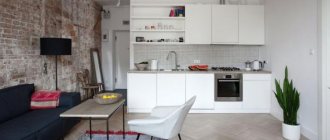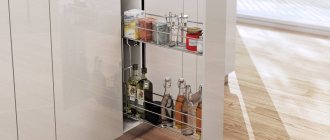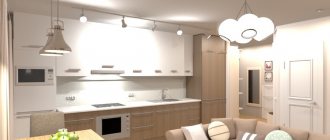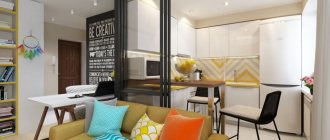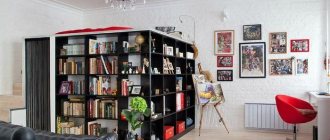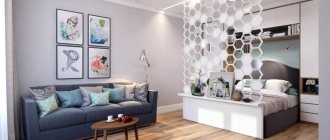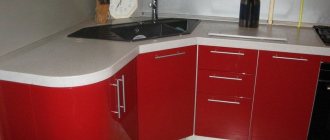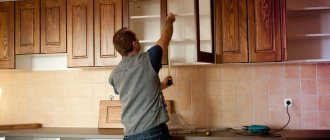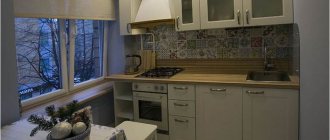An “L”-shaped or corner kitchen set is the most versatile and convenient layout option. It fits perfectly into small kitchens. Allows you to optimally zone the space of large and narrow, elongated rooms. Such a set occupies space along two adjacent walls, and the length of the two “legs” can be completely different:
- one is long, located along a blank wall, the second is noticeably shorter, consisting of 1-3 cabinets. As a rule, it occupies the space between the corner and the window or door;
- two lines of cabinets are the same length, which is suitable for square kitchens;
- There is a difference in length, but it is insignificant.
In addition, corner sets are often complemented with bar counters, islands and peninsulas. This equipment gives the kitchen a special look and creates additional comfort during cooking, family meals and entertaining guests.
There are a lot of design and configuration options for corner kitchen units. Modern manufacturers offer a wide range of finished products suitable for almost any layout. In addition, you can use universal modular solutions, varying the number, location and purpose of lockers at your discretion.
Today we will look at the most popular trends for corner kitchens, select the most ergonomic arrangement of household appliances and sinks, and determine the size of the furniture elements.
Corner kitchen: design and its features
Corner kitchens, photos of which are presented in a wide variety in various design print and online publications, are one of the most universal solutions, as they have a unique property - they can fit into a room of any size, the interior of which is decorated in any style. This property is especially attractive for arranging mini-kitchens.
If we consider the options for corner kitchens, we can distinguish their three main components: one is located in the corner, and two are located on the side of it.
Photo from source: designwiki.ru Tabletop Cedar 1110/S White
Layout features
There are many options for L-shaped layouts. Let's look at the most popular and convenient ways to arrange kitchen units and household appliances in order to leave space for the dining area and free movement.
With a sink in the corner
A sink in the corner is a convenient way to zone the work area, as well as rationally use the space. There are 3 ways to position the sink: to the right or left of the corner, as well as in the center.
For right-handers, it is more convenient to place the sink on the left, so that the dryer is on the right. If this is not possible, you should not give up drying. An inconveniently located dryer is better than an empty corner.
The sink in the center of the corner allows you to use the entire space of the countertops to the right and left of it. But this method of arrangement also has disadvantages. If the sink is installed at the junction of two countertops at a right angle, then it will be inconvenient to use. Therefore, it is recommended to install the sink in a sloping cabinet in the corner so that, if necessary, you can get close to the sink.
Corner with island
An island is an element of a set that is placed in the center of the room. The result is an additional work surface and storage system. In addition, the island can serve as a dining table, where it is convenient to have breakfast or a snack.
The island can be stationary in the form of a cabinet, with open shelves inside, on wheels. In size it can be quite large, like two kitchen cabinets, or compact.
A large island is only suitable for large kitchens, since it is difficult to find space for another cabinet in a small area. But small mobile options can also be considered for a small room.
The island can also become a replacement for wall cabinets, which are increasingly being abandoned today in favor of more modern storage systems.
L-shaped with bar counter
A popular way to make efficient use of a small space is to install a bar counter instead of a dining table. But it can also act as an element of space zoning, for example, in a large room or studio apartment.
Typically, the bar counter is installed perpendicular to one of the countertops, which allows you to get a built-in dining area and an additional work area. The bar counter can be a continuation of the window sill, in which case the complex area near the window is rationally used.
If you don’t know how to place a kitchen unit in a room with two windows, then a corner kitchen with a bar counter will be an excellent solution. In this layout, the main set with wall cabinets, a stove and a sink is placed near a blank wall, and a worktop is placed near the windows. The bar counter is located opposite the main set, perpendicular to the tabletop by the window. This is an excellent option for a studio, as the counter allows you to visually separate the kitchen area from the living room.
The bar counter can be with storage drawers, a hinged lid, or empty inside. The last two options are suitable for small corner kitchens, as they save space.
With a refrigerator or geyser
It is not so easy to fit a large refrigerator into a small corner kitchen, but it is possible if you approach the matter rationally. The refrigerator is installed at the entrance to the room or at the window, where it is the final element of the set.
You can design a niche for the refrigerator so that it looks more harmonious and is part of the composition. There may be mezzanines on top of it, which increases storage space. If you have space, you can put a pencil case up to the ceiling next to the refrigerator. But this technique is only suitable for studios or large rooms.
Today the gas water heater is hidden behind one of the doors of the upper drawers. If the kitchen is up to the ceiling, then even the corrugated pipes will not be visible. To adjust the temperature and gas supply, just open the door. It is important to place the column at a sufficient distance from the gas stove and, of course, not above the sink.
A small corner kitchen with a refrigerator or gas heater is possible if you use the space wisely and do not try to fit a maximum of elements in a small area.
With windows on both sides
Typically, windows become the main problem when placing a corner set. In this case, you can use a technique that is often found in American interiors. It consists of placing a work area with a sink near the window, which is not only practical, but also very beautiful and stylish.
You can hang a storage cabinet or shelves between two windows, and leave free walls for larger structures, such as a speaker or refrigerator. Of course, if there are two windows, you will have to use the maximum space below, since the top of the walls cannot be used for storage areas.
Corner kitchen living room
A kitchen combined with a living room can truly become the main decoration of the whole house. With such layouts, designers try to make the kitchen the center of attention, use the best materials and the most daring solutions.
As a rule, large kitchens are made from valuable types of wood in noble shades; large dining tables made from the same wood are often placed nearby. At such a spacious table you can gather a large group, and due to the proximity of the kitchen surfaces, it will be convenient for the hostess to serve food and drinks.
In any case, you shouldn’t concentrate too much on the catering unit, because besides it, there is a lot of furniture and objects in the living room that should not be “in the shadow” of the kitchen.
Corner kitchen project: where to start?
The central part is where you should start when planning a corner kitchen unit. And after that, expand it to the required length.
The main elements of the kitchen are the upper and lower modules.
But additional ones include:
- false boxes, in which, as a rule, all communications necessary in the kitchen are hidden;
Photo from source: pinterest.ru Table top Cedar 3852/P Corsica Oak
- bar counter;
Photo from source: pinterest.ru
Tabletop Cedar 1021/Q Black
— chrome roof rails;
Photo from source: smartshapiro.ru
— cornices equipped with additional lighting;
Photo from source: pinterest.ru Tabletop Cedar 759/1 Black bronze
— sections with built-in household appliances.
Photo from source: extraspace.com Tabletop Cedar 3021/S Roman Travertine
Lighting
An important point to pay attention to is the lighting of the room. The corner kitchen can be equipped with additional lighting for the convenience and beauty of the interior.
- Original lighting behind glass cabinet doors will visually expand the room.
- Strips with LEDs at the top of the cabinets will make the furniture visually lighter.
- The glossy surface of the furniture and reflective glass details will add light to the kitchen interior.
The corner kitchen layout will serve as an excellent option for decorating a small or medium-sized kitchen space. Properly selected furniture will not only help save space in the kitchen and visually increase the space, but will also make it functional and convenient for the housewife.
About the advantages of a corner kitchen and its design
So what are the advantages of a corner kitchen design? You always want to talk about good things as much as possible, so let’s expand on this question:
• functionality - in such rooms, as a rule, corner sofas are placed. They are small, but they give the kitchen maximum comfort. This is a great additional storage space, since under the seat of the sofa you can hide the most rarely used items;
Photo from source: houseandhome.com
• compactness - they do not take up much space, but also help to use space efficiently;
Photo from source: interiors.beyhomedecor.com
Tabletop Cedar 2073/Pw Light Oak
• the ability to create effective zoning by dividing the kitchen space into two zones.
Photo from source: scavoliniusa.com Tabletop Cedar 111/1 White
Tips for choosing furniture
The size of the room and the style of the interior play a huge role when choosing furniture. Therefore, some tips can help with choosing a configuration.
If the kitchen is small, then it is recommended to place the lower and upper cabinets on either side of the corner to provide maximum storage space.
If the room is spacious, then it is advisable to install the upper cabinets only on one side of the corner, and decorate the other side, for example, with paintings or hang shelves. The second option would be to use cabinets on the other side, which will contain built-in appliances.
Advice! In the latter option, cabinets should have blank fronts. This will imitate a wall, which will prevent the interior from becoming cluttered.
Even if the choice is a corner kitchen, this is not a reason to refuse a corner sofa. It can also fit into the interior, the main thing is to match the chosen design. In addition, it is not only more compact than a table with chairs, but can also provide additional storage space located under the seats.
For whom are corner kitchens most relevant?
• for owners of studio apartments or kitchen-dining/living rooms;
Photo from source: behance.net
Tabletop Cedar 7461/FL Redondo
• area less than ten square meters.
Photo from source: apartmenttherapy.com
If the area is still larger, the set is complemented by an island/peninsula, and additional cabinets are installed along the wall on the opposite side.
Photo from source: hqroom.ru Tabletop Cedar 4091/Q Damask steel
Tricks for arranging small corner kitchens
• reducing the depth of one of the sides of the tabletop by 10 - 15 cm - of course, in this case, the useful storage space is reduced, but there is more freedom of movement;
Photo from source: pinterest.ru
• tabletop equipment under the window - when one side of the set is located along the wall with a window. This could also be a mini-tabletop or bar counter;
Photo from source: inmyroom.ru
• installing the peninsula so that one of its sides is along the wall, and the shorter side is across and not adjacent to the wall. Thus, freedom of access to the peninsula is provided on both sides at once. A bar counter/desk can be used as a peninsula. Firstly, it turns out very ergonomic. Secondly, it provides an excellent opportunity to zone the room;
Photo from source: intera-mebel.ru
• creating narrower and taller headset modules than standard options - thanks to this technique, the ceiling height visually increases and the headset looks beautiful;
Photo from source: helsingo.com
• right angle - perhaps this is the best option if the room is small. After all, a trapezoidal angle will take up more space compared to a straight one.
Photo from source: pinterest.ru
How to properly arrange a kitchen?
From an ergonomic point of view, a sink located in a corner is not the most practical option if there are cabinets above it. It’s better to move a little to the side and make a tabletop in the corner. Also on sale there are cabinets with a projection of 20-30 cm, they will be much more convenient to use. Also evaluate the shape of the sink: round ones are not very practical, but they save space; rectangular ones are more convenient to use.
It is also worth considering where to place the stove. If it is near a window, then keep in mind that the distance from the hob to the wall should be at least 40 cm. The hood can be located at a height of 65-75 cm from the stove.
The refrigerator can be either a built-in part of the headset or act as a separate object. If it is a part, it should continue the furniture line and match in color and style. A refrigerator located separately stands out somewhat from the overall picture, however, even corner models have appeared on sale, so choosing the right one will not be difficult.
The matter becomes somewhat more complicated if your kitchen has all kinds of protrusions, corners, beams and crossbars. Of course, ventilation shafts, ducts, pipes greatly complicate life: in this case, the set is often “torn apart”; you should not try by all means to mold the two sides of the corner into one whole.
In kitchens with corners and ledges, there is no need to focus on the abundance of upper modules, otherwise the work area will seem heavy and bulky. It is better to place closed cabinets on one side of the corner, and on the other wall - open shelves, hoods, decor, and so on.
Are there any downsides to a corner kitchen layout?
A corner kitchen has not only advantages, but also disadvantages. Since we are honest with our readers, we will tell you about the disadvantages of the project in as much detail as about the advantages:
• if the drawers are open, they will prevent the doors on the side from opening. If you have to plan a corner kitchen, this point should definitely be thought out in advance;
• it is almost impossible to purchase such a set ready-made, so it is necessary to draw up a project for a personal order. Thus, more time is spent on order production; installation requires professional assemblers;
• if you plan to place a sink in the corner, in order to use the space with maximum benefit, you need to equip the corner cabinets from both the lower and upper rows with special fittings. For example, baskets/retractable shelves/multi-story carousel.
Advantages
A corner set for a small kitchen creates the most comfortable working triangle. Thanks to the increased ergonomics of this arrangement, the housewife can easily use the refrigerator, sink, stove, and work surface.
In such a kitchen, not a single minute is wasted, which allows you to cope with the cooking process much faster.
Additional advantages of the L-shaped arrangement of objects are:
- Compactness and the ability to furnish a kitchen with a non-standard layout.
- Visual approximation of the far wall in narrow rooms.
- Capacity. Corner kitchen cabinets allow you to use usually empty space without losing functionality, and sometimes get additional storage space due to trapezoidal cabinets.
- Originality. The rotating and circular sections look very unusual, make it easier to get to objects located on the far wall and improve your mood with their ease of use and unusual opening mechanisms.
- Convenient zoning. In fairly spacious rooms, the dining group is placed in the corner opposite from the suite, highlighting the dining area without unnecessary design techniques and the cost of material and time.
Any shaped room is suitable for arranging furniture in an L shape, although it is best to use it in a square room.
How to use a corner in a corner kitchen wisely?
Don't forget that a corner is also a valuable area that can be very useful as a place to store or display something. Among the techniques for effectively using this space, we list the following:
- installation of a rectangular set combined with a corner cabinet - this solution will create a visual impression that these are two different cabinets, but inside it will be a single space. This technique is practical and ergonomic;
Photo from source: interiorexplorer.ru
- placing built-in household appliances in the corner will give the kitchen unit the most neat appearance and make the corner functional;
Photo from source: asko-russia.ru
— installation of a corner cabinet equipped with a “carousel” inside, which greatly facilitates access to everything that is stored inside the cabinet and provides the maximum amount of free space;
Photo from source: alimpia-mebel.ru
- appearance is something that should not be forgotten, even if the emphasis is on functionality - to make the kitchen space airy and light, the corner can be equipped with open shelves. In addition, this will help save a share of the budget spent on the manufacture of kitchen units and expand the free space;
Photo from source: pinterest.ru
— "train" fastenings in cabinets - structures specifically designed so that during the process of opening the cabinet, the shelves are pulled out one after another. Thanks to this, there is unhindered access to all items stored in them. Even those that are in the far corners of the closet;
Photo from source: sakhmebel.com
— placing a hob or sink in a corner is one of the most useful options for its operation. Sinks with two bowls look especially interesting;
Photo from source: hansloren.pl
— placing the dish dryer in the shape of the letter “L” will not present any difficulty and will provide easy access to the contents.
Photo from source: hypermarketmebel.ru
First stage of work
First of all, you need to measure the dimensions of the kitchen and make a drawing. When the drawing is created, a list of installed equipment and furniture is compiled, and its arrangement is indicated on the drawings. An option for a small kitchen space could be like this:
- sink in the corner space, combined with a cabinet;
- a cabinet located above the corner sink;
- two bedside tables standing along the walls and adjacent to the corner sink on the left side and right side;
- two cabinets suspended above the bedside tables;
- a place where a gas stove will be installed, or a cabinet for installing a stove and oven.
To accurately represent the dimensions of the kitchen, you need to measure the length of the walls at several levels: at the top, under the ceiling, below, above the floor, and in the middle of the wall. The height of the walls is also measured: in each corner and in the middle of the walls.
It may turn out that the walls are not completely level, and this must be taken into account. The dimensions of the kitchen must be indicated on the drawing, and the dimensions of the installed kitchen appliances and furniture are also marked on it.
When designing a kitchen, be sure to focus on the accepted standard cabinet sizes. For floor ones they are:
- depth 600 mm;
- height 850 mm;
- width of double door cabinet 800-900 mm;
- the width of a single-door cabinet is at least 600 mm;
- the distance between the cabinet and the wall is 50-100 mm (the tabletop should extend to this distance against the wall);
- on the front side, the tabletop usually extends beyond the edge of the cabinets by 30-50 mm.
Wall cabinets also have their own standardized dimensions:
- depth 300 mm;
- height 700-900 mm;
- the distance from the tabletop to the bottom edge of the wall cabinet is at least 450 mm;
- there must be at least 750 mm of space from the stove to the hood;
- The width of each wall cabinet usually corresponds to that of the lower one standing underneath it.
Corner kitchen options
When choosing the type of layout, it is imperative to take into account all the features of the room, including its dimensions.
A universal option is to place the headset along two walls that are perpendicular to each other. In fact, this is a classic version of a corner kitchen, so it will fit perfectly into most rooms. It will also allow you to arrange equipment and modules to your liking.
Photo from source: pinterest.ru
A corner kitchen set, complemented by a bar counter, turns into a “U”-shaped or “F”-shaped set. In the case of the second option, the tabletop is installed in the center of the set. This looks great in kitchens that have a fairly large area.
Photo from source: pinterest.ru
Design ideas
To significantly save space, they prefer corner kitchens with built-in appliances or appliances hidden behind the facades of the unit. In addition to saving square meters, this solution reduces the noise level emanating from operating devices, which is especially appropriate for the interior of a kitchen-living room.
Another way to make good use of space is to install a headset up to the ceiling. This increases the capacity of the structure, and the design takes on a more holistic look.
The three-meter kitchen, which does not cover the entire wall, has a very harmonious and stylish appearance. This layout frees up space for a dining group.
The photo shows a corner kitchen set with facades stylized as wood.
The photo shows a white corner kitchen with radius facades.
Trapezoid-shaped structures can be supplemented with cabinets of very different configurations. Such products with a beveled corner have more internal space and often look more bulky.
The photo shows an interior with a light suite and built-in appliances.
Modular kitchens are a real construction project. They are able to adapt to any design and geometry of space and rationally use the right or left corner in the room.
The photo shows a wooden set with a black tabletop, made in the right corner.
What role does the bar counter play in a corner set?
The design of a corner kitchen in a modern style often involves the presence of a bar counter. Proof of the real benefit of having this element, first of all, will be the fact that it is capable of performing several functions simultaneously:
- become a continuation of the main tabletop, creating additional workspace;
Photo from source: theidentite.co
- a mini-alternative to the dining table - especially relevant in cases where the kitchen area is not enough to arrange a full-fledged dining area;
Photo from source: ivd.ru
- helps to effectively zone the room - if it is necessary to separate the kitchen and living room, work area and dining room;
Photo from source: projectsgallery.ru
- Helps provide additional storage space.
Photo from source: cantileverinteriors.com
The bar counter is an element that will look great in kitchens whose interior is decorated in any style.
Today, the kitchen furniture market offers a huge range of different sets that already have built-in bar counters. But even if the kitchen you like does not have a bar counter, you can always order its production separately. The main thing is to take into account wishes for configuration, size, as well as all the features of the kitchen space.
Photos of kitchens in a private house
In a spacious kitchen in a country house, it is appropriate to install a unit with an island or dining area in the center. In addition, with this arrangement, the room can be equipped with two panoramic windows or a completely glass door leading to the terrace.
The photo shows a kitchen design in a country house with a wooden corner set in a green shade.
Modern style corner kitchen sink
The “L”-shaped kitchen layout, in which the sink is located in the corner, is very common. This is especially true if the corner kitchen is in an apartment in a Khrushchev-era building. If the angle is right, mini-model sinks in the shape of a circle, or rectangular ones with one or even two bowls, are suitable.
Photo from source: pinterest.ru
How to place furniture?
The corner kitchen provides a comfortable work triangle layout with a refrigerator, sink, and hob. For more competent placement of furniture, it is necessary to prepare a room plan that displays the exact proportions of the room, the location of sockets, the presence of corners and protrusions.
Storage systems
For greater convenience, various storage systems are thought through, for example, drawers, regular shelves, rotating carousel sections, etc.
A corner cabinet helps maximize space optimization and can easily fit into a corner-shaped kitchen. In the side part of the set you can place high, spacious pencil cases that do not clutter up the room.
The photo shows a corner set equipped with open side shelves.
In an L-shaped kitchen, the refrigerator is placed in one row with the furniture or placed opposite the corner cabinets.
Cooking area
It is advisable to build the hob, stove and oven into the lower cabinets, and place the microwave in the upper hanging modules.
The photo shows a small kitchen in the shape of a corner with a stove built into the lower cabinet.
It is better to install these devices as close to each other as possible so that they are not visually lost in space.
Washing area
A trapezoid-shaped cabinet is suitable for placing the sink. This option is quite rational and is often used in the interior of small kitchens. For a sink, it is better to choose a small round product or a two-bowl model.
The photo shows a small corner kitchen with a sink near the window.
It is advisable to install wall cabinets with a dryer above the sink. If you have a dishwasher, it is better to place it in close proximity to the sink.
Lunch group
Since the L-shaped kitchen is located only in one corner, the other can be decorated with a compact table.
The photo shows a dining area with a sofa located in the bay window.
For a more spacious room, a full-fledged dining table and several chairs or a kitchen corner with a sofa and a couple of stools would be suitable.
About arranging a ventilation ledge or duct when planning a corner kitchen
If the apartment is in a new building or in a standard house, then the angular location of the air duct is the norm, but the headset significantly complicates the process of creating a design project.
If the ventilation box is small, it is easy to bypass it. To achieve this, the depth of the floor cabinets is reduced.
If the box protrudes forward, then the most reasonable solution is to divide it into two parts.
Photo from source: mykaleidoscope.ru
Beige kitchen
I will never tire of repeating that beige is the best color for renovation. This is a natural and pleasant color. Almost all the interiors of our studio are made in beige tones. Personally, I think the most optimal shade is gray-beige. It can be called universal, as it goes well with other colors. By the way, we have prepared an interesting selection of interiors and design projects for beige kitchens. Be sure to come check it out!
Features of the corner tabletop
Make a headset in the corner just a work surface - why not? Here you can conveniently place a jug of water, a toaster, a table-top dish drainer, a microwave or a coffee maker - in general, small household appliances and necessary kitchen utensils.
Photo from source: tanjavanhoogdalem.nl
Sections
The kitchen consists of upper and lower sections. The top row consists of hanging shelves and cabinets; light kitchen utensils, textiles, and food are stored in them . Sometimes the upper sections are also used for decorative purposes - paintings, tea sets, and vases are placed on them. A multi-tier carousel shelf is installed in the corner of the headset - it is spacious and ergonomic. The bottom row consists of floor cabinets. They are designed for storing large-sized dishes and equipment, food supplies. The depth of the bottom row corresponds to the size of the tabletop - 500-600 mm.
Attention! In addition to the upper and lower sections, separate modules are placed in the corner kitchen: cupboards, chests of drawers, cabinets. Such furniture looks especially relevant in antique or vintage interiors. Tableware is stored in cupboards, and decor and kitchen textiles are stored in chests of drawers. Due to their compact size, cabinets are used for storing food and small utensils.
Hood
The kitchen hood is placed above the hob, or less often - above the worktop. The distance from the hood to the stove must be at least 70 cm, while the width of the hood is 5-10 cm greater than the width of the hob. For corner kitchens, domed or T-shaped models are relevant. They have an open working panel and are suitable for modern and classic interiors. Retractable models are in demand - left-handed or right-handed hoods. Before installation, it is important to make sure that it will slide out without problems.
Attention! How to make a corner kitchen from a straight kitchen? To do this, you need to connect the corner of the kitchen into a linear module. It is important to take measurements first so that the updated set fits into the room.
How to take measurements correctly
Experts recommend using a tape measure with a steel blade for measuring. It is better to take another person as a partner so that you can comfortably reach every corner. Many houses have uneven walls, so measurements are taken at three height levels - 150, 850 and 2000 mm from the floor level. The diagram should indicate the distances from the floor and from each wall. If the household appliance is built-in, it is important to determine its dimensions in advance and write it down on a separate piece of paper.
Cutting materials
Before you start cutting out the dimensions of the kitchen, it is important to decide not only on the design of the corner cabinet for the kitchen, but also on the material of manufacture. Masters choose:
- MDF sheets. They are strong and durable, do not deform due to temperature changes, and consist of environmentally friendly components. MDF does not fade in the sun and is resistant to cleaning agents.
- Chipboard sheets. They are cheaper, but the material cannot boast of a pure composition and long service life. Chipboard is used mainly for the manufacture of economy class kitchens.
After choosing the material, proceed to the cutting map. This is a document with information about what parts need to be cut from the sheet. The cutting map shows how the elements can be placed and how much material will remain. You can make it yourself on a computer using the Cutting program or order it from the store where you purchased the material. The cutting chart indicates the dimensions of each cabinet, determines the dimensions of the top, bottom, side walls, edges, shelves and facade.
How to assemble
First, check the availability of all tools and materials. You will need a screwdriver and a hammer drill with a set of different drills, as well as hexagons, rulers and a building level. Purchase hammers, screws and pliers, as well as an iron for smoothing the edges.
The process of assembling kitchen cabinets looks like this:
- The side shelf is installed with its end up and 3 through holes are made in it (one in the middle and 2 at a distance of 40 mm from the edge) on the top and bottom sides for wooden spatulas.
- Cross-shaped fastenings for doors are attached to the side boards using self-tapping screws. If the cabinet is equipped with retractable mechanisms, then the rails are secured.
- Attach the second wall to the box and get a kitchen cabinet. They check it for symmetry; the error should not be more than 2 mm.
- The legs are attached to the bottom with screws, and their height is adjusted if necessary. If the cabinets are wall-mounted, wall fittings are attached to the back.
After collecting the boxes, they begin to install the countertop. It is laid on cabinets, leaving a distance of 3-5 mm to the wall. The tabletop is mounted with special fasteners, and the gap is decorated with furniture plinth. Metal strips are placed in the corners (in the area where the countertops meet) to mask the gap. At the final stage, the furniture decorative edge is glued using an iron.
Fasteners
First, the lower tier of the kitchen unit is attached, starting from the corner of the room. Markings are made on the wall, the distance between the floor and the base is at least 10 cm. It is important to remember that the gaps between the cabinets should be minimal. If the floor is uneven, it is recommended to purchase adjustable legs to make it easier to find the optimal kitchen height.
Most often, kitchen cabinets are attached to the wall using special “ears”. This is a metal part, one side of which is attached to the box, and the other to the wall. The advantages of such fasteners include simplicity and low cost; the disadvantages are the inability to further adjust the height of the cabinets.
A more common and practical method of fastening is using adjustable canopies. Canopies mounted on a mounting plate are mounted in the box. Thus, the box can be adjusted down and up or back and forth. Adjustable canopies are more expensive than “ears”. The upper section is hung at least 600 mm from the level of the countertop, periodically leveling the cabinets using a building level.
Decoration
Design plays no less a role than the standard dimensions of a kitchen unit, the choice of material, the process of measuring, assembly and installation. They think over the color scheme at the stage of drawing up the drawing. For small rooms, choose white and its shades - creamy, ivory, pearl. White color visually enlarges the space and makes it fresher. For large kitchens or spacious studio apartments there are no color restrictions.
To give the kitchen an elegant glossy effect, the facades are painted with enamel paint. This is an affordable and environmentally friendly material; among all the colors it is easy to choose the one that suits a particular interior. Lamination of facades (hot pressing) is also used, in which the kitchen acquires a shiny and reflective effect. Glossy kitchens are easy to clean and look original. If you don’t like gloss, choose matte facades - they create an intimate and cozy atmosphere. Thanks to the porous surface, hand and food marks are less visible on the matte headset.
Attention! Fittings will help make your kitchen stylish and unique: handles, edges, roof rails. A classic set will be decorated with unusual ornate handles with a “bronze” effect; a minimalist kitchen will be decorated with linear or curly strict options. Hooks and metal rails will also serve as decoration; spices, towels, mugs, and cutlery are placed on them.
Neoclassical
Modern style, which is an interesting mix of timeless classics and trendy modern elements. This is a very practical design that prefers the use of natural materials or their high-quality imitations. For example, the most suitable “marble” or “wood” countertop can always be found in the catalog of the Kedr factory.
Photo from source: polinov.ru Tabletop Cedar 2337/S Beige marble
White kitchen
Anyone interested in all-white kitchens clearly isn't afraid of cleaning. I will make you happy - such kitchens do not require frequent cleaning. They are no different from regular models. After cooking, you need to clean up after yourself and wash the facades a couple of times a week. Nothing more special is required! But to make the kitchen more practical, I advise combining different materials. Light-colored facades are very easily soiled; I recommend using light wood for their finishing. And the facades on top can be snow-white. But let me note for those who are especially obsessed with cleanliness, you can make facades with the texture of wood or stone. In this case, it is better to immediately abandon monochromatic options!
Provence
“Province” is how the name of this style is translated from French. But such a “rustic” designation does not prevent it from being sophisticated and modern. Simplicity and naturalness are the qualities that attract the most in Provence style interiors. If we touch on the topic of choosing a palette, then light shades are a priority. Also among the characteristic features of the style are the presence of floral patterns in textiles, ornaments, ceramic dishes, as well as the effect of an aged surface on furniture.
Photo from source: housebeautiful.com Tabletop Cedar 920/1 Milanese marble
Two-level kitchen sets
To accommodate all the accessories necessary for the kitchen, you can install two-level corner sets. When thinking through such a layout, be sure to look at the furniture arrangement diagram. The selection of headsets of the second tier is made taking into account:
- their functional characteristics;
- dimensions;
- materials used;
- design features.
Several light sources Source designadvice.ru
The most important point when designing such a corner kitchen is determining the height of the work surfaces. In this case, not only the height of the walls is taken into account, but also the height of the household. The most popular material for a two-level kitchen is MDF or chipboard.
Two-level kitchens with the letter L are made in different stylistic solutions:
- Provence (warmth and comfort of Mediterranean colors);
- classicism (complex device with subtle additions);
- militarism (compactness and simplicity).
U-shaped kitchen Source goldenplaza.com.ua
If there is not enough light in the kitchen with the letter L, it is advisable to make it in the following colors:
- apricot;
- vanilla;
- peach;
- light chocolate;
- pink.
When the windows of the room face the sunny side, the kitchen set of such a room can be:
- red;
- lemon yellow;
- jade;
- gray.
Design options Source dizayndoma.com
The choice of a corner pattern when installing a headset with the letter L is prepared from the center, systematically moving to the walls. The emphasis in the corner kitchen is on floor cabinets with wall cabinets. You can add such a room:
- hanging curtain rods with lighting;
- bar counter;
- sections for built-in equipment;
- false boxes for communications;
- chrome roof rails.
Any of the stylistic trends can be decorated with notes of avant-garde or novelty, making it fashionable and modern.
Beige kitchen in minimalist style Source art-kuhni.com
Modern style
If we list the most practical interior design styles, then modern will probably take first place. After all, there is nothing superfluous here. All lines and shapes are clear and strict. Among the features of corner kitchens in a modern style are:
— the presence of a variety of hidden, but no less spacious lockers;
— use of built-in equipment;
- a restrained palette.
Finishes that imitate natural stone are also very popular here. Such materials can be used literally in everything: when finishing walls, floors, kitchen aprons, countertops. High-quality examples of the latter are available in the catalog of countertops from the Kedr factory.
Photo from source: pinterest.ru
Tabletop Cedar 3027/S Granite white
Dimensions
The main condition is the correct calculation of the space for the working and other important areas. There are compact modern corner kitchens, due to which you can distribute the maximum number of pieces of furniture in a limited space.
For small rooms, designers recommend ordering them according to individual parameters in order to compactly integrate household appliances.
Loft
This is a very original brutal modern style filled with industrial elements. Here you can see a lot of rather rough-looking surfaces and interesting textures - walls with exposed brickwork, like untreated wood surfaces, concrete, uncoated chipboard sheets, plaster, etc. The surfaces are usually matte, the lines are strict.
Photo from source: designwiki.ru
Table top Cedar 5141/Mn Moon
Corner kitchen in modern design: about trends
First of all, let's touch on the most important question: what angle to make - beveled or straight?
Yes, a beveled one will provide the best access to the contents of the cabinet, but today it is corner kitchens with right angles that are in trend. And this solution also has advantages - such modules will take up less space than trapezoidal ones, so they can be used even in the smallest kitchens. And the issue of access to content can be easily resolved by using “smart” accessories.
Photo from source: homify.ru
Reducing the countertop on one side by 10-15 centimeters is a trend and also a trick that will free up more space in the kitchen.
Photo from source: ivd.ru
Creating a peninsula or bar counter will help create an additional work area and zone the space.
Photo from source: mykaleidoscope.ru
Choosing tall, narrow modules will help make the ceilings appear higher.
Photo from source: 3ddd.ru Ergonomics
Refrigerator placement
A familiar refrigerator, standing alone in the kitchen, is a spacious and relatively budget option. But it requires a lot of space. The standard size of the refrigerator is 59 cm, to which technological clearances for air circulation should be added. The built-in version takes up exactly 60 cm.
In addition, a free-standing refrigerator breaks the lines of the corner layout of the room and does not fit into the interior of the room.
A corner kitchen with a refrigerator will look harmonious if you provide it with a separate niche with gaps, decorated in the same style. The second successful solution would be a built-in refrigerator.
